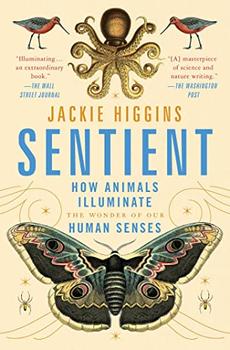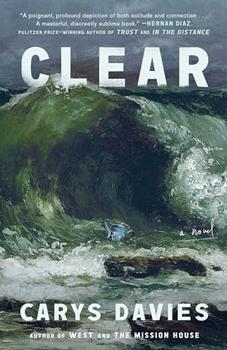Summary | Excerpt | Reviews | Beyond the Book | Readalikes | Genres & Themes | Author Bio

Critics' Opinion:
Readers' Opinion:
First Published:
Feb 2022, 320 pages
Paperback:
Nov 2022, 320 pages
 Book Reviewed by:
Book Reviewed by:
Elisabeth Herschbach
Buy This Book
Chapter One
True to its various names, the peacock, painted, or harlequin mantis shrimp is one of the most colorful creatures on the Great Barrier Reef. Neither shrimp nor mantis, Odontodactylus scyllarus is more akin to a diminutive lobster with a kaleidoscopic carapace of indigos, electric blues, and bottle greens. Yet this captivating countenance belies a somewhat irascible temperament. One spring day in 1998, at the Sea Life center in the English seaside town of Great Yarmouth, a particularly pugilistic specimen named Tyson astounded onlookers by smashing through the thick glass wall of his aquarium. "He was clawing and snapping. Nobody dared touch him;' the manager told the national press. "All our visitors assume our sharks are the man-eating killers, but they are pussycats compared to Tyson. His power is incredible:' Tyson was not the first to attempt such a jailbreak; these marine crustaceans, known as stomatopods, have developed quite a reputation among aquarists and scientists. Indeed, research has shown that the peacock mantis shrimp uses its dub-like arms to pack a punch faster and more forceful than any heavyweight boxer.
One scientist at the University of California, Berkeley, made it her mission to understand the mantis shrimp strike, but only because she had run into problems with her original research plan. "I decided to take a break from trying to study their sound production and look instead at a behavior they perform regularly, without hesitation;' explained Sheila Patek. "It was a classic example of how failure can open up new and unexpected directions:' Her first challenge was to find a camera system fast enough. "Standard high-speed video cameras, that film at 1,000 frames per second, are too slow to capture the creature's strike. They only show a single frame of blur;' she said. An opportunity arose to team up with a BBC film crew and use the latest high-speed technology for low light conditions. "Low light is the critical issue when filming these animals;' because, "if it's too high, you fry them." The experiment was simple to set up: a peacock mantis shrimp, a sacrificial snail loosely tethered to a stick - "they are aggressive animals, happy to strike whatever is placed in front of them" - and, sure enough, they soon had a recording of a shell-splitting impact. They had filmed the punch at 5,000 frames per second, and, playing it back, they slowed it down by a factor of three hundred. "It was still pretty darn fast;' Patek told me. "Even a back-of-the-envelope calculation for the speed and acceleration of the strike put them right at the outer limits of what people had ever seen." The final calculation was more surprising still: it was the fastest strike ever recorded in the animal kingdom. "It is a glorious moment as a scientist to see something for the first time and recognize how special it is," Patek added. The calcified club accelerated like a bullet in a gun, reaching its target in three-thousandths of a second, at velocities approaching 80 kilometers (50 miles) per hour. "But that was not the end of the story."
Patek decided to film the behavior at even faster speeds. "At 20,000 frames per second, we saw an incredible flash of light where the limb hit the snail, that then spread over the shell" she said. "I recognized it instantly." She was looking at a potent phenomenon called cavitation, which occurs where areas of water moving at vastly different speeds meet and the pressure drops. "This results in the water literally vaporizing and when that vapor bubble collapses, it does so with such destructive force that it emits sound, heat, and light." The experiments revealed that the force behind the peacock mantis shrimp's fist is so great that sparks really do fly. The knockout blow spells doom for aquarium walls and any snails unfortunate enough to be within reach. Patek's research enabled the Guinness World Records to claim it, relative to the animal's weight, as "the most powerful punch in the animal kingdom." But the mantis shrimp shows prowess beyond the boxing ring
*
Just inland from the Great Barrier Reef and the Coral Sea, the University of Queensland's Brain Institute is perhaps an unlikely global hub for stomatopod science. "My major research love in life is the mantis shrimp;' confessed Justin Marshall, the professor in charge of the sensory Neurobiology Group. He and his team are often seen swapping lab coats for snorkels and scuba gear to brave encounters with these plucky crustacea and keep their aquarium well stocked. "The local fishermen call them thumb-splitters so we have to be careful," he informed me. "We collected this peacock mantis shrimp a few weeks ago on the reef just off Lizard Island. They are secretive creatures, often hidden away. This one was between a couple of rocks, so we put the net at one end, then prodded the other, and he shot straight into our trap:' As Marshall peered down into a glass tank, a pair of protuberant, purple-hued eyes returned his gaze. "These eyes are unique;' he explained. "Even the way they look at you is disturbing. A shrimp will fix you with its eyes, turn its back, scratch its behind, then turn back to eyeball you again, just like a monkey might do; as if they have primate-like awareness." Little seems to escape the stare of a mantis shrimp. Seemingly curious eyes swivel on stalks, independent of one another and rarely in the same direction or at the same time. Scientists have shown that whereas we humans need two eyes for depth perception, the mantis shrimp needs only one. This is the first of many visual talents. As Marshall told me, "Its eyes are more powerful than its right hook."
Excerpted from Sentient by Jackie Higgins. Copyright © 2022 by Jackie Higgins. Excerpted by permission of Atria Books. All rights reserved. No part of this excerpt may be reproduced or reprinted without permission in writing from the publisher.





The House on Biscayne Bay
by Chanel Cleeton
As death stalks a gothic mansion in Miami, the lives of two women intertwine as the past and present collide.

The Flower Sisters
by Michelle Collins Anderson
From the new Fannie Flagg of the Ozarks, a richly-woven story of family, forgiveness, and reinvention.

The Funeral Cryer by Wenyan Lu
Debut novelist Wenyan Lu brings us this witty yet profound story about one woman's midlife reawakening in contemporary rural China.
Your guide toexceptional books
BookBrowse seeks out and recommends the best in contemporary fiction and nonfiction—books that not only engage and entertain but also deepen our understanding of ourselves and the world around us.